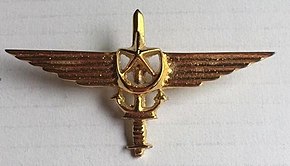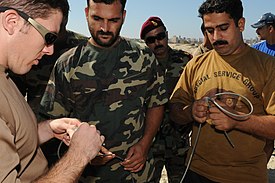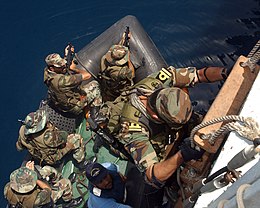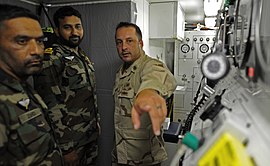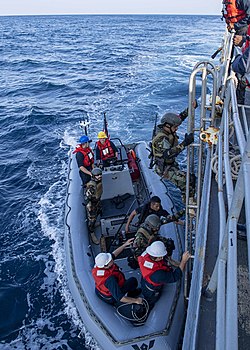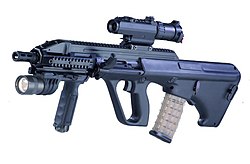
The Pakistan Armed Forces are the military forces of Pakistan. It is the world's sixth-largest military measured by active military personnel and consist of three formally uniformed services—the Army, Navy, and the Air Force, which are backed by several paramilitary forces such as the National Guard and the Civil Armed Forces. A critical component to the armed forces' structure is the Strategic Plans Division Force, which is responsible for the maintenance and safeguarding of Pakistan's tactical and strategic nuclear weapons stockpile and assets. The President of Pakistan is the Commander-in-Chief of the Pakistan Armed Forces and the chain of command is organized under the Chairman of the Joint Chiefs of Staff Committee (JCSC) alongside the respective Chiefs of staffs of the Army, Navy, and Air Force. All branches are systemically coordinated during joint operations and missions under the Joint Staff Headquarters (JSHQ).

The United States Naval Special Warfare Command (USNSWC), also known as NAVSPECWARCOM and WARCOM, is the naval component of United States Special Operations Command, the unified command that oversees and conducts the nation's special operations and missions.

The Pakistan Navy (PN) is the uniform naval warfare branch of the Pakistan Armed Forces. The President of Pakistan is the Supreme Commander of the Navy. The Chief of the Naval Staff, a four-star admiral commands the navy. The Pakistan Navy operates on the coastline of Pakistan in the Arabian Sea and Gulf of Oman. It was established in August 1947, following the independence of Pakistan from the United Kingdom.

The Marine Commandos, abbreviated to MARCOS and officially called the Marine Commando Force (MCF), are the special forces of the Indian Navy. The MARCOS were originally named Indian Marine Special Force, which was later changed to Marine Commando Force to impart "an element of individuality" to it, according to the Indian Navy. The abbreviation 'MARCOS' was coined afterwards.

The Kopaska is the premier frogman and underwater demolition unit of the Indonesian Navy. The unit's motto is in Sanskrit: Tan Hana Wighna Tan Sirna. The unit's main duties are underwater demolition, destroying main underwater installations, reconnaissance, prisoner snatches, preparing beaches for larger naval amphibious operations, and counter-terrorism. During peacetime, the unit also deploys a team to serve as security personnel for VIPs and VVIPs. The personnel of Kopaska are recruited from Indonesian Navy seamen. Like other Indonesian special forces, Kopaska is trained to be able to conduct operations in the sea, including underwater, on land and airborne.

The Pakistan Air Force Special Services Wing is a special operations force who specialised in all aspects of air-to-ground communication, including air traffic control, fire support, command, control and communications in covert counterterrorism or austere environments. Their functionality is similar to American Air Combat Control Team of the United States Air Force. They are often assigned individually or as a team to Army Special Service Group, Navy Special Service Group, Pakistan Rangers and special tactics units of the Pakistan Marines, to provide expert airfield seizure, airstrike control and communications capabilities.

The Pakistan Marines or simply as Pak Marines, is an expeditionary and amphibious warfare uniform service branch within the Pakistan Navy, consisting of the naval officers and other personnel to perform their duties within the Marines. Pakistan Marines are responsible for providing force protection in littorals, using the mobility of the Pakistan Navy to provide creeks defence, ground based air defence and Force protection.

Vice-Admiral Syed Mohammad AhsanHQA, SPk, DSC, DMM, LOM often known as S. M. Ahsan, was a senior admiral of the Pakistan Navy who was the Commander in Chief of the Pakistan Navy, serving under President Ayub Khan from 1966 until 1969.
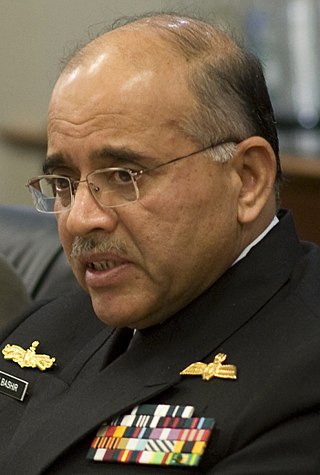
Noman BashirNI(M) HI(M) SI(M) TI(M) LoM was a Pakistan Navy admiral who served as the 18th Chief of Naval Staff (CNS) from 7 October 2008 until retiring on 7 October 2011.
Admiral Tariq Kamal KhanNI(M) HI(M) SI(M) LoM, is a retired four-star rank admiral and a former diplomat who served as a Chief of Naval Staff (CNS) of Pakistan Navy from being appointed in 1983 until retiring from his service in 1986.

The Cosmos-class submarine, officially Cos.Mo.S MG-110 locally designated as X-Craft, are the class of midget submarines designed by the Italian firm Cos.Mo.S, in Karachi Naval Dockyard in Karachi, Sindh, Pakistan.
Admiral Iftikhar Ahmed SiroheyNI(M) HI(M) SBt OM BJSN LoM is a retired four-star rank admiral, strategist, and a memoirist who is currently tenuring his fellowship at the Institute of Strategic Studies (ISS) in Islamabad, Pakistan.
The Indo-Pakistani Naval War of 1971 refers to the maritime military engagements between the Indian Navy and the Pakistan Navy during the Indo-Pakistani War of 1971. The series of naval operations began with the Indian Navy's exertion of pressure on Pakistan from the Indian Ocean, while the Indian Army and Indian Air Force moved in to choke Pakistani forces operating in East Pakistan on land. Indian naval operations comprised naval interdiction, air defence, ground support, and logistics missions.
The PNS Mehran attack was an attack/shooting by Tehrik-i-Taliban Pakistan (TTP) and Al Qaeda which took place on 22 May 2011, at PNS Mehran, the headquarters of the Pakistan Navy's Naval Air Arm and the most populous Pakistani military installation, located near the PAF's Faisal Air Force Base of Karachi, Sindh.

The Pakistan Army Special Service Group is the special operations forces of the Pakistan Army. They are also known by their nickname of "Maroon Berets" due to their headgear.
Military exercises are conducted by the Pakistan Armed Forces to increase combat readiness, and to identify problems in logistics, training, and current military doctrine. They also test the ability of units to work together. Lastly, they act as a visible expression of military might, which acts as a deterrent to potential enemy action. An important component of each exercise is the after-action assessment. Since 1989 the four branches services have increasingly begun coordinated exercises.
The PNS Iqbal is the naval base that serves as the training and operating headquarters of the Navy Special Service Group, having been established in 1966 at the Karachi coast in Sindh in Pakistan.
Vice-Admiral Jawaid Iqbal is a retired three-star-admiral of the Pakistan Navy, politician, and diplomat who served as the Ambassador of Pakistan to Tunisia from 1998 to 2004. The Government of Pakistan conferred the Sitara-e-Basalat and Hilal-i-Imtiaz awards on Iqbal for his contributions to the nation.

PNS Khaibar (DDG-183) is the Tariq-class destroyer currently in active duty in the Surface Command of the Pakistan Navy since 1994.
